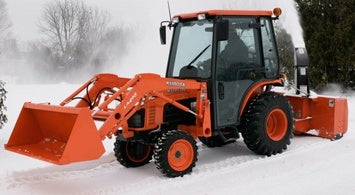
After a season of record snowfall in parts of North America, the equipment that got you through that winter deserves a little TLC.
Tractor
We’re big fans of regular service intervals reflective of what’s found in owner’s manuals. Spring is the perfect time to break out the Service Record History and catch up on what is due.
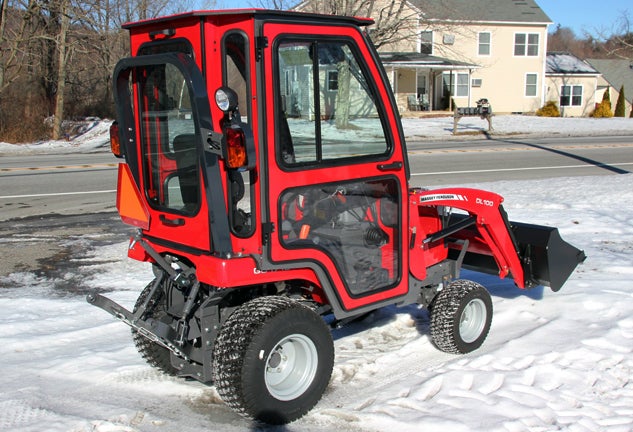
Obvious areas are the fluids and filters that keep your machine going, but there are other things to be aware of that are not always so obvious. Grease fittings need attention, too. Manufacturers seem to put zerks in locations not easily noticeable or accessible, such as at the axle pivot point, tie rod ends, and power steering cylinders ends. Then there are lubrication points that are easy to overlook. Apply a good quality lubricant to places such as the seat adjustment rails, selective control valve (SCV) and other linkages that need to move freely for ease of operation. The three-point hitch has many areas that pivot such as the ball ends, lower link attachment points, upper link arm and turnbuckle, as well as the stabilizer system used.
Open the hood and check the alternator belt for proper tension. Your owner’s manual should state a method of determining correct tension such as Apply moderate thumb pressure to belt halfway between the pulleys. Belt should deflect inward approximately 9mm (3/8 in.). Check the battery terminals for corrosion. A simple solution of four tablespoons baking soda to a gallon of water works great for cleaning. Just be careful of getting any of the cleaning solution into the battery cells. After cleaning the terminals, apply petroleum jelly or a silicone spray to the exposed surfaces. Check radiator hoses for signs of heat fatigue and then check the clamps for tightness. Turn on the lights and flashers/turn signals, if any won’t operate, check for a blown fuse or defective bulb. And before closing the hood, clean air intake grills and screens. Debris here can often lead to engine overheating.
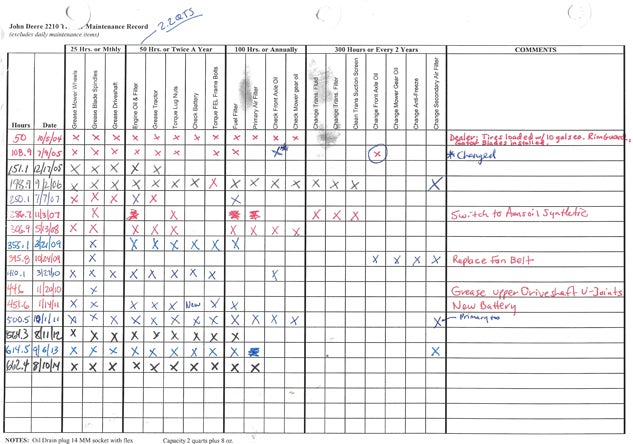
Bolts and nuts can come loose over the winter. Check these for proper torque, referring to your owner’s manual for each attachment point’s proper rating, and paying special attention to wheel hardware (lug nuts). A good quality torque wrench can be invaluable here. A little trick is to check a fitting for proper torque, then paint a dash over the checked bolt/nut. One year use white, then black the next. You’ll easily spot any that you’ve overlooked.
Loader
A front end loader (FEL) is quite commonly used for snow removal. Those that have this versatile implement know its ability to move, pile and relocate large snowfalls that a plow might struggle with. Loader maintenance is pretty simple, mainly consisting of greasing the fittings which can range from as few as ten to more than twenty. But there are areas of premature failure to be on the lookout for. Cycle the loader throughout its range by raising, lowering, curling and dumping. Watch for slow or jerky operation. If this occurs, it may be a sign hydraulic fluid level is low or that connections are loose, but it also could mean the cylinders have internal leakage issues. If this is the case, your manufacturer offers a cylinder repair kit.
With many pivot and scrape points, often painted surfaces will become bare. Repainting is an option, but typically that is a short lived fix. Our solution is just to apply a good quality lubricant to those surfaces and live with the exposed metal. Another issue common with loaders is excessive drift/leak down. Sometimes this is indicative of internal hydraulic cylinder leakage, but it could also point to worn or damaged O-rings in the tractor SCV. And lastly, take a look at the bucket. Is the cutting edge experiencing excessive wear? If so, it may be due to the angle of use where the wear pads aren’t allowed to do their job. Check your owner’s manual for proper use.
Blower
A blower is preferred by many to relocate snow with the added versatility of being able to redirect the output by rotating the chute as well as the distance by the spout height adjustment. At the end of the season, check the gearbox oil level and add recommended gear oil as needed. Gearboxes are generally designed for long life with little maintenance, and your owner’s manual may not even have a fluid replacement interval. In that circumstance, though, we would still drain and replace the gear oil at least every five to seven years. If the blower is a three-point hitch (3PH) mounted model, there will be a power take off (PTO) shaft that will have grease fittings at each end. Likewise, if your blower is a front mounted unit, it too will have a driveshaft with grease fittings. Grease the PTO shaft/driveshaft and work it in and out so the square shaft inside is well lubricated. And the auger shaft (one for a single stage, but a two-stage will also have an impeller) will also have zerk fittings to lubricate.
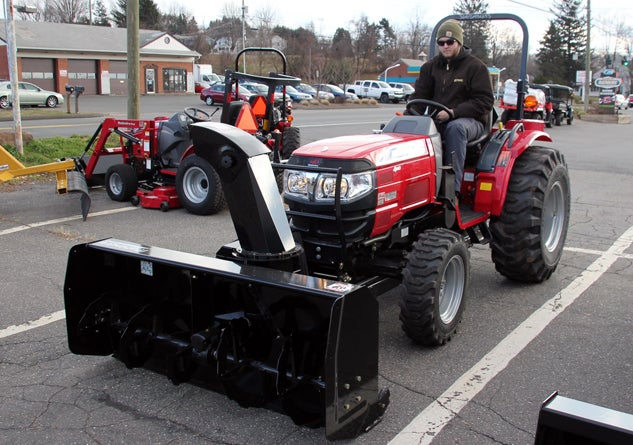
A MyTractorForum.com member who will remain anonymous told us this winter during one of the biggest snowfalls, his blower abruptly stopped. It turned out that he had neglected lubricating the chain and sprockets driven by the driveshaft. Over the season(s) the chain had gone dry and began to stretch. As the chain stretched, it put additional strain on the sprockets, which resulted in the retaining bolt loosening. When the sprocket fell off, the keyway fell into the snow . . . somewhere. You get the rest of the story. Lubricate your chain and sprockets; check the retaining bolt for tightness, and it’s probably prudent to have an extra chain and keyway on the shelf (not to mention extra shear bolts).
Depending on the system used to rotate the chute, there may be cables to check for condition and a hydraulic cylinder to monitor for proper operation. Lastly, check the condition of the scraper blade and skid shoes. If worn, the shoes may need to be adjusted lower. If the scraper blade is excessively worn, it usually can be reversed before replacement is needed. And before putting the blower away for the season, coat any worn areas with a light lubricant. Fluid Film is always at the top of our preferred lubricant list.
Plow
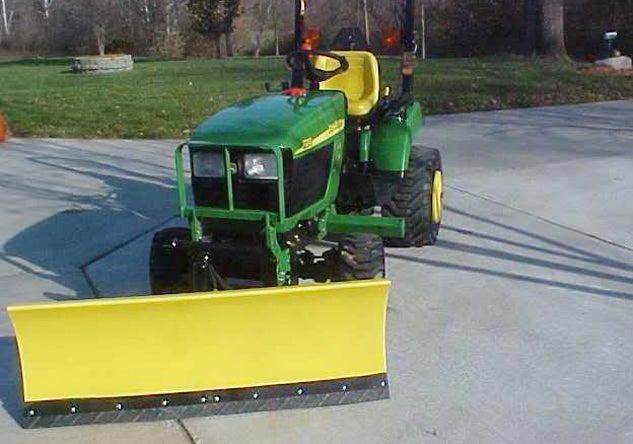
A front plow is especially useful for the quick clearing of large areas. The basic design is simple and the amount of moving parts minimal. Maintenance is therefore minimal and simple, but don’t neglect your plow. Start with the pivot points and linkages which all require lubrication. Inspect the cutter edge for wear and need of replacement. A nifty trick that protects your driveway and cutter is a rubber blade. Manufacturers sell these, but purchase a rubber horse stall mat and you’ll be able to cut out many for much less. For the blade, touch up painted surfaces either by brush or spray can.
Wrap Up
Do the simple and required maintenance at winter’s end and you won’t be in a panic when that unexpected snow next falls and you fall prey to the same trap the abovementioned MyTractorForum.com member did. Manufacturers know winter equipment takes a beating and their designs are based accordingly. With proper maintenance, you can expect extended life along with the peace of mind that everything will work when you most need it.
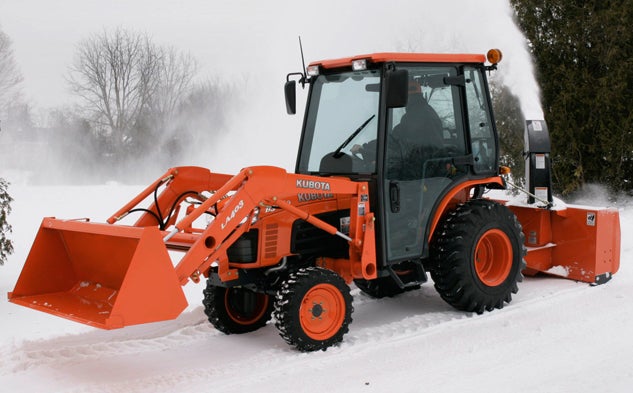
 Your Privacy Choices
Your Privacy Choices